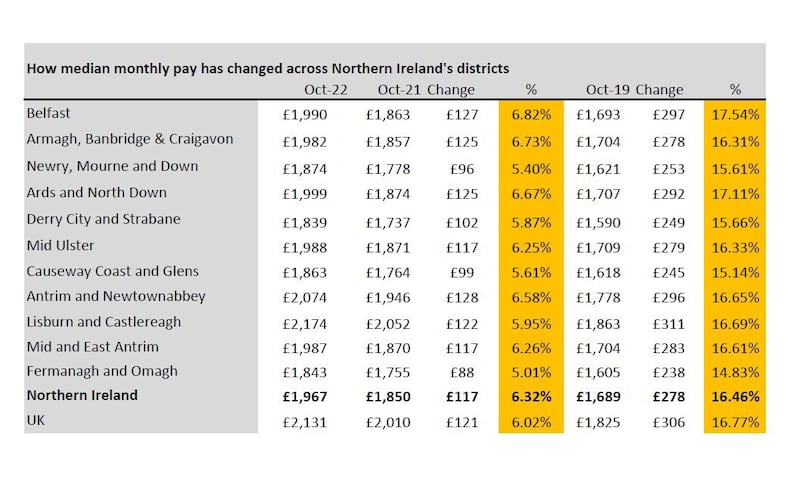THE average monthly wage in Northern Ireland has increased by 6.3 per cent in the past year, official data shows, but real incomes are still falling due to soaring inflation.
The median wage increased to £1,967 per month in October according to HMRC, £117 more than October 2021 and £278 (16.5 per cent) higher than October 2019.
The UK’s Office of National Statistics (ONS) revealed on Tuesday that inflation jumped to 11.1% in October - the highest rate since October 1981 - as gas and electricity costs rocketed, despite Government support limiting the rise in bills.
The wage data published as part of November’s labour market report from the Northern Ireland Statistics and Research Agency (Nisra) showed significant disparity in earnings between some parts of the north.
In the highest earning council district, Lisburn and Castlereagh, the median monthly wage stood at £2,174 in October. That was £335 more than the median wage in Derry and Strabane (£1,843 per month) and £331 higher than Fermanagh and Omagh (£1,843).
Wage growth was weakest in Fermanagh and Omagh, increasing by just 5 per cent (£88) in a year, less than half the rate of inflation (11.1 per cent).

Belfast recorded the strongest wage growth over the year, with the median salary rising £127 (6.8 per cent) to £1,990 per month in October.
That was followed by Armagh, Banbridge and Craigavon, where the median monthly wage rose £125 (6.7 per cent) in a year to £1,982.
Belfast also recorded the highest three-year wage growth, climbing by 17.5 per cent (£297) since October 2019.
Overall, Northern Ireland retained its status as having the lowest median earnings in the UK. Nisra said the 12.7 per cent wage growth recorded here since Covid-19 hit in March 2020 was also the lowest of all the UK regions and 2.7 percentage points lower than the UK average (15.4 per cent).
READ MORE: Inflation jumps to 41-year high of 11.1 per cent due to surging energy bills
The latest labour market report did show an improvement in the number of people on payrolls here last month.
A total of 781,262 people were registered on HMRC’s PAYE (pay as you earn) system during October, 1,295 more people than September.
The 940 confirmed redundancies over the past 12 months was also the lowest on record.
Yet the data has also pointed to a weakening in the wider labour market.
The unemployment rate has officially climbed to 3 per cent for the three-month period to September, while around 500 people were added to the claimant count in October.
The count, which includes people claiming jobseeker’s allowance and universal credit claimants, who were claiming principally for the reason of being unemployed, rose to 36,100 in October.







